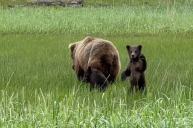In movies, if a character ends up dead with their head and hands cut off, chances are, they're being used by a criminal organization to send a frightening message to the public. But when it happens to a grizzly bear, it's in the species best interest. That's what officials say at least.
The image of a grizzly bear missing its head and paws that surfaced this week raised more questions than answers. Many on the internet presumed that some savage massacred the graceful animal or poachers harvested parts to sell on the black market. But officials say it was the opposite.
How did the grizzly bear die?
"This is the same bear that was removed last week after several weeks of conflict in Gardiner," said Morgan Jacobsen, a spokesman for Montana's Fish, Wildlife & Parks, in an interview with KPAX.
In a statement, the agency said wildlife officers killed the bear after it became food-conditioned. The term refers to when a wild animal relies more on humans for food than its instincts for hunting or foraging. In turn, it may result in the animal becoming more aggressive toward people.
As a result, the bear became the focus of multiple conflicts throughout June. Officials say the bear regularly sought and obtained unsecured food from homes, businesses, and vehicles. It also broke into homes in search of food.
However, on July 18, wildlife officers began searching for the bear after it had broken into a home in a town just north of Gardiner. They eventually found it near the Yellowstone River, where they killed it.
What happened to its head and paws?
Jacobsen explained that after wildlife officers shot the grizzly bear, it took a while for it to die. So officers followed its trail to where it had collapsed, which was downstream in the river. However, due to the location, they could not recover the animal's body.
"So something that we are required to do as an agency by the U.S. Fish & Wildlife Service is to remove any parts of that bear — of that carcass — that have potential monetary value," Jacobsen said. "So that includes the head and the paws."
Most states prohibit the sale of bear parts, specifically black bear parts like paws and gallbladder. Wildlife experts say those parts often end up on the black market to fill a demand for not just collecting but holistic medicine as well.




